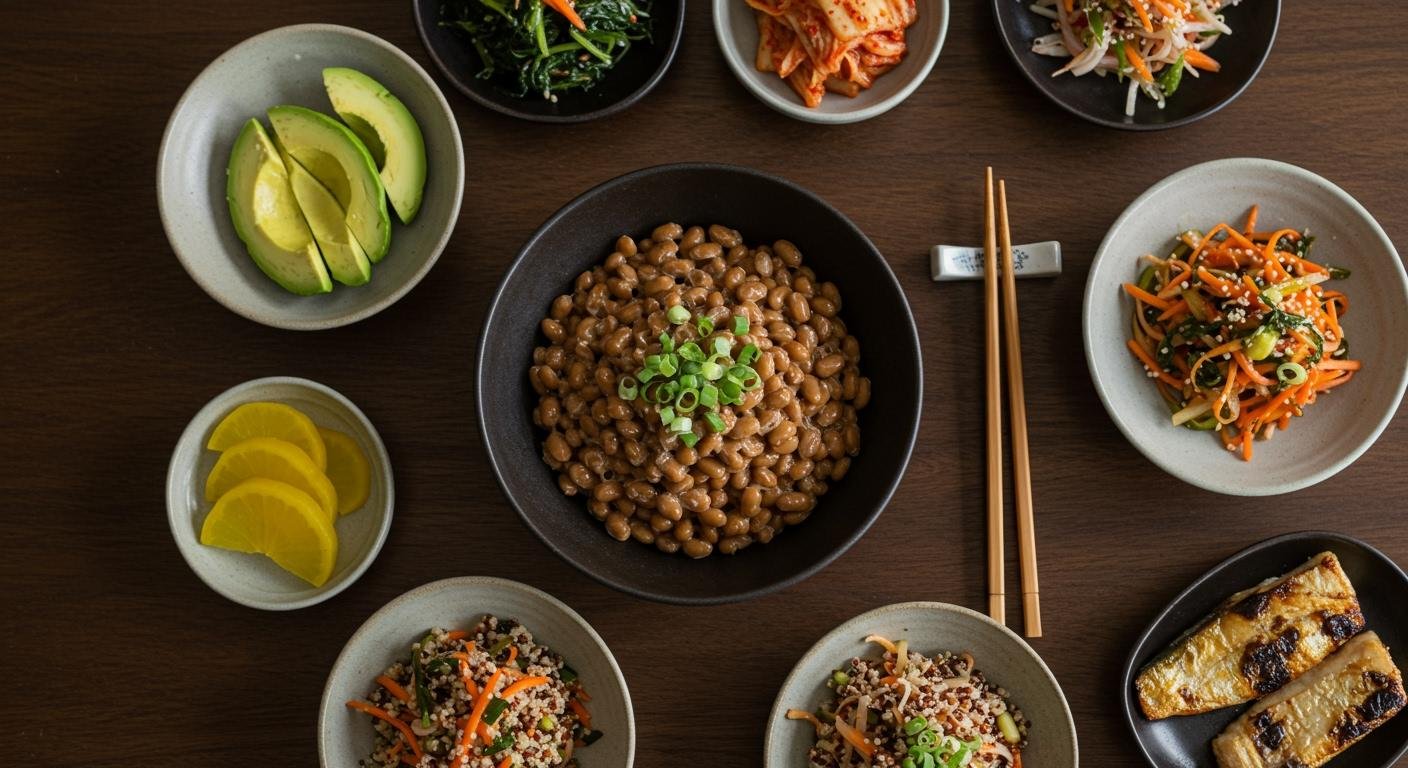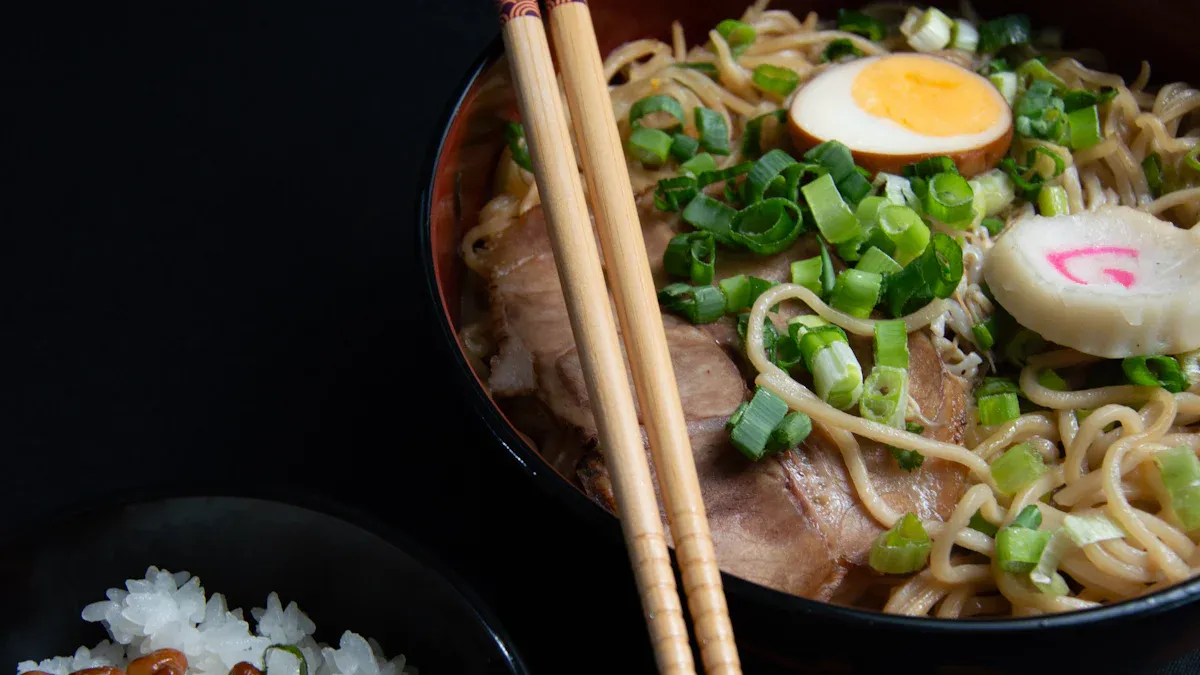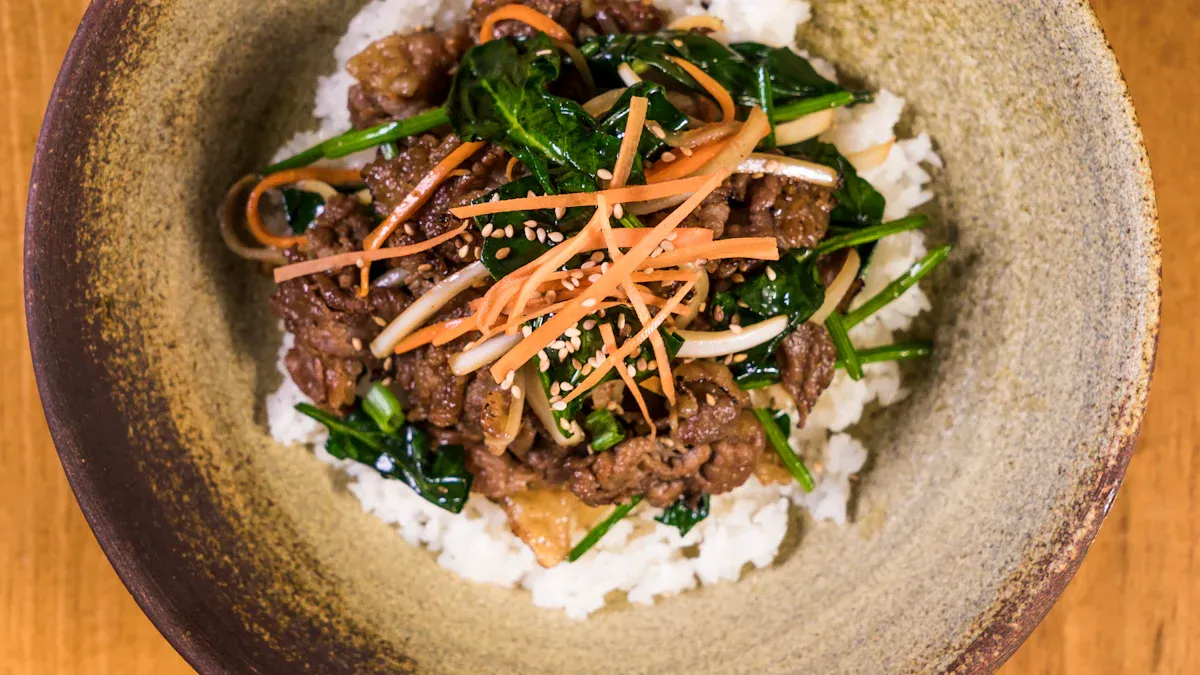What Soy-Free Sides Pair with Natto?
Table of Contents

Wondering how to eat natto without soy? You’ve come to the right place! You can easily pair this superfood with fresh vegetables, creamy avocado, and tangy, non-soy pickles. Finding delicious ways to enjoy natto is simple, even with a soy sensitivity.
Did you know? Natto is one of the richest food sources of Vitamin K2 (as MK-7). This vitamin is crucial for directing calcium to your bones, which helps keep them strong. So, when you enjoy natto, you’re also supporting your bone health!
While a soy allergy is not extremely common, finding great soy-free sides is key for those who need them. Learning how to make natto taste good for your palate is the goal.
| Location/Age Group | Prevalence of Soy Allergy (%) |
|---|---|
| US (age 1 year) | 1.5 |
| US Adults (self-reported) | 0.4 – 0.8 |
| Zurich, Europe | 0.08 |
| Utrecht, Europe | 0.03 |
Top Soy-Free Sides for Natto

Fresh vegetables are fantastic soy-free sides for natto. They add a crisp, cool crunch that balances the sticky texture of the fermented beans. You can find many delicious ways to enjoy natto with a simple vegetable pairing. Whether you prefer them cooked or raw, you have plenty of great options.
Cooked Vegetables
Cooked okra is a classic partner for natto. Its slightly slimy texture, known as “neba-neba” in Japanese, complements natto perfectly. This combination creates a uniquely satisfying dish. Preparing okra is simple and quick.
Pro Tip: To reduce the fine hairs on okra, you can roll it with a little salt on a cutting board before boiling. This makes the texture even better!
Here is how you can prepare this simple side:
- Bring a small pot of salted water to a boil.
- Add your fresh okra and cook for about 2 minutes. You want it to be bright green and tender-crisp.
- Quickly move the okra to an ice bath. This stops the cooking and keeps the color vibrant.
- Pat the okra dry and slice it into thin rounds.
- Mix the sliced okra with your natto. You now have a simple, healthy, and vegan meal!
Raw Vegetables
Raw vegetables offer a refreshing contrast to the strong flavor of natto. They are one of the easiest ways to enjoy natto. A popular choice is grated daikon radish, which adds a mild, peppery bite. Sliced cucumber is another excellent option, providing a cool and watery crunch.
You can easily turn your natto into a quick salad. Just mix in your favorite chopped veggies. This is a great way to add nutrients and texture. Try these simple additions for a refreshing natto salad:
- Diced cucumber
- Thinly sliced green onions
- Shredded carrots
- Chopped watercress
Simple Natto Recipes
If you want to turn natto from a side dish into a more substantial snack or a light meal, these simple natto recipes are perfect for you. Adding richer ingredients like creamy avocado or savory eggs creates a satisfying and balanced dish. These pairings are easy to prepare and offer delicious ways to enjoy natto.
Avocado Pairings
Avocado is a fantastic partner for natto. Its smooth, buttery texture and mild flavor beautifully complement the strong taste and sticky consistency of the fermented beans. This combination is a favorite for a reason!
You can easily prepare natto with avocado for a quick vegan meal. Simply mash half an avocado and mix it with your natto. For extra flavor, add some thinly sliced green onions and a dash of soy-free sriracha. Another great idea is an Avocado Natto Rice Bowl. Just top a bowl of rice with natto, sliced avocado, and a sprinkle of toasted sesame seeds. It’s one of the most simple and fulfilling natto recipes.
Egg Pairings
Eggs are another versatile ingredient that pairs wonderfully with natto. The richness of the yolk cuts through the natto’s earthy flavor, creating a delicious harmony. You can start by simply topping your natto with a fried or poached egg.
For a more traditional Japanese experience, you can try making a special kind of soft-cooked egg.
Pro Tip: Make Onsen Tamago! This classic Japanese egg has a silky, custardy white and a creamy, liquid yolk. To make it without special equipment, bring a pot of water to a boil, turn off the heat, and gently place your eggs inside. Cover the pot and let them sit for about 20 minutes before moving them to an ice bath.
Another one of the great natto recipes involves making Natto Tamagoyaki, which is a Japanese rolled omelet with natto mixed into the eggs. You can even make a quick version in the microwave! Mixing eggs with natto is a fantastic way to enjoy natto for breakfast or a protein-packed snack.
Fermented and Pickled Sides
Adding another fermented food to your bowl can create an amazing flavor explosion. The tangy, acidic crunch of pickles cuts through the richness of natto perfectly. You have many delicious options that go far beyond just soy sauce. These soy-free sides add a new dimension of taste and texture, making it even more fun to enjoy natto.
Non-Soy Japanese Pickles
Japanese cuisine offers a huge variety of pickles, called tsukemono, and many of them are completely free of soy. They provide a sharp, refreshing contrast to the earthy flavor of natto. You can find these at most Asian grocery stores or even try making them at home. Look for these fantastic choices:
- Gari: Thinly sliced sweet pickled ginger, the same kind you get with sushi.
- Takuan: A bright yellow pickled daikon radish that has a sweet and tangy crunch.
- Shibazuke: A Kyoto-style pickle made from cucumber and eggplant, brined with red shiso leaves for a beautiful purple color and unique taste.
- Beni Shoga: Julienned ginger pickled in plum vinegar, offering a sharp, salty bite.
Kimchi and Sauerkraut
Don’t limit yourself to just Japanese pickles! The bold, spicy funk of kimchi is a powerful and popular pairing for natto. The combination is a powerhouse of probiotics. Classic sauerkraut also works well, offering a simpler, sour crunch that complements the natto. Most sauerkraut is naturally vegan and soy-free. However, you need to be careful with store-bought kimchi.
Heads Up! 🧐 When buying kimchi, always check the ingredients list. Some brands use tamari for an umami boost. Tamari is a type of soy sauce, so you should avoid any kimchi that lists it if you need a completely soy-free meal.
Mixing in these zesty fermented foods is a simple way to elevate your natto experience.
Hearty Grains and Starches

Pairing natto with a hearty grain or starch is the perfect way to turn it into a filling and satisfying meal. The neutral flavor of grains provides an ideal canvas for the bold taste of natto. You can create a complete dish in just minutes.
The Classic Natto Rice Bowl
The most iconic way to eat natto is with a simple bowl of steamed rice. This classic combination, known as natto gohan, is a staple in Japan for a reason. The warm, fluffy rice balances the sticky texture and strong flavor of the natto perfectly. You can easily make a delicious natto rice bowl at home.
To prepare this dish, just scoop your prepared natto over rice. That’s it! Many people enjoy natto on rice for a quick breakfast or lunch. For a more complete meal, you can add some of the other toppings mentioned in this guide to your natto rice bowl. A simple bowl of rice truly lets the natto shine.
Alternative Grain Bases
While rice is the classic choice, you have many other options to enjoy natto. Exploring different grains can add new textures and flavors to your meal. Noodles are an especially fantastic alternative.
Quick Meal Idea: 🍜 Try making a simple natto pasta! Toss your favorite cooked noodles with natto, a splash of olive oil, and some fresh herbs. It’s a fast, unique, and delicious way to get your natto fix.
You can create a wonderful dish with Japanese noodles like buckwheat soba or thick udon noodles. Just be sure to check the ingredients, as some noodles contain wheat. For a gluten-free and vegan option, try pairing natto with rice noodles or quinoa. These alternative bases open up a whole new world of ways to enjoy natto. Mixing natto with cold noodles on a hot day is also incredibly refreshing.
Essential Toppings for Natto
The right toppings can completely transform your natto experience. Sprinkling on some seeds, spices, and fresh herbs is a simple way to add exciting layers of flavor and texture. These little additions make it even more fun to enjoy natto.
Seeds and Spices
Seeds and spices are an easy way to add a crunchy, flavorful kick to your natto. Toasted sesame seeds are a simple and classic choice, adding a nutty taste. For something more complex, you can try a Japanese spice blend.
A great option is Shichimi Togarashi. This is a traditional mix that often includes sesame seeds, orange peel, nori, and a bit of chili pepper. While togarashi is the Japanese word for chili pepper, this blend offers much more than just heat. It’s used to spice up rice and vegetable dishes, making it a perfect topping for your natto.
Fresh Herbs and Aromatics
Fresh herbs and aromatics add a bright, zesty flavor that cuts through the earthiness of natto. Finely chopped green onions are a classic, but you can get more creative. Try adding fresh cilantro or shiso leaves for a unique twist.
Ginger and garlic are also fantastic flavor builders for natto. While you can buy pre-made pastes, making your own is much tastier. A fresh, homemade ginger-garlic paste offers a superior flavor that jarred versions just can’t match. You can even make a batch and store it in your fridge for weeks.
How to Prep Your Aromatics
- Julienne or finely grate your fresh ginger.
- Mince your garlic into very small pieces.
- Mix them directly into your natto and stir well!
These simple additions will elevate your bowl of natto with fresh, powerful flavor.
Soy-Free Sauces and Condiments
The right sauce brings everything together when you eat natto. A good sauce adds moisture and a savory, umami flavor that complements the fermented beans. You have plenty of delicious soy-free options to choose from.
Soy Sauce Alternatives
Finding a great soy sauce alternative is key to making your natto taste amazing. Coconut aminos are a popular choice. It is a dark, savory sauce made from fermented coconut sap. It gives your natto a rich flavor without any soy.
Heads Up! 🧐 Be careful with other common alternatives. Liquid aminos and tamari are often mistaken as soy-free, but they are both soy products. Always check the label!
Here is a quick look at how these sauces compare in flavor:
| Alternative | Flavor Profile |
|---|---|
| Coconut Aminos | Milder, sweeter, less salty, umami, doesn’t taste like coconut |
| Soy Sauce | Richer, saltier, more complex and developed flavor |
| Liquid Aminos | Dark, salty, similar to soy sauce |
| Tamari | Darker, richer, slightly less salty than traditional soy sauce, bolder, stronger flavor than soy sauce |
Coconut aminos are also a great choice if you are watching your sodium intake. You can see how much lower it is compared to soy-based sauces.
| Product | Sodium per Teaspoon (5 ml) |
|---|---|
| Coconut Aminos | 90 mg |
| Traditional Soy Sauce | 280 mg |
| Liquid Aminos | 320 mg |
| Tamari | >300 mg |
Flavorful Oils and Vinegars
You don’t always need a soy sauce-like condiment to enjoy natto. Flavorful oils and vinegars can add a wonderful new dimension to your dish. A drizzle of toasted sesame oil gives your natto a nutty, aromatic boost. For a tangy kick, try adding a splash of rice vinegar. This bright acidity cuts through the richness of the natto beautifully. You can even mix a little sesame oil and rice vinegar together for a simple, delicious dressing for your natto.
You now have a fantastic list of soy-free sides to pair with your natto. You can choose from crisp vegetables, creamy avocado, tangy pickles, or hearty grains. Remember, you don’t have to miss out on delicious natto dishes just because of a soy sensitivity. Enjoying natto is easy!
Now it’s your turn to get creative in the kitchen. Mix and match these soy-free sides to build your perfect natto meal. Happy experimenting! 🧑🍳
FAQ
What does natto taste like?
Natto has a strong, earthy flavor that many people compare to aged cheese. You will notice its famous sticky and stringy texture. It is a unique taste that many people grow to love. Give it a try!
Where can I buy natto?
You can find natto in the refrigerated or frozen section of most Asian grocery stores. Some larger supermarkets also stock it in their international food aisles. Look for it near the tofu and other fermented products.
Is natto gluten-free?
Yes, plain natto is naturally gluten-free. However, you should always check the included sauce packets. They often contain soy sauce made with wheat.
Remember: It’s safest to use your own certified gluten-free sauce, like coconut aminos, to be sure.
How do I make natto less sticky?
The more you stir natto, the stickier it becomes! For less stickiness, stir it only a few times. You can also mix it with other foods like rice or avocado to help break up the strings.

Poseidon
Master of Nutritional Epidemiology, University of Copenhagen, Herbal Functional Nutrition Researcher
Focus: The scientific application of natural active ingredients such as Tongo Ali, Horny Goat Weed, and Maca to sexual health and metabolic regulation.
Core Focus:
Men: Use a combination of Tongo Ali (an energizing factor) + Maca (an energy reserve) to improve low energy and fluctuating libido.
Women: Use a combination of Horny Goat Weed (a gentle regulator) + Maca (a nutritional synergist) to alleviate low libido and hormonal imbalances.
Stressed/Middle-Aged Adults: This triple-ingredient synergy supports metabolism, physical strength, and intimacy.
Product Concept:
Based on traditional applications and modern research (e.g., Tongo Ali promotes testosterone-enhancing enzyme activity, and icariin provides gentle regulation), we preserve core active ingredients and eschew conceptual packaging—using natural ingredients to address specific needs.
Simply put: I'm a nutritionist who understands "herbal actives." I use scientifically proven ingredients like Tongo Ali, Epimedium, and Maca to help you make "sexual health" and "nutritional support" a daily routine.
